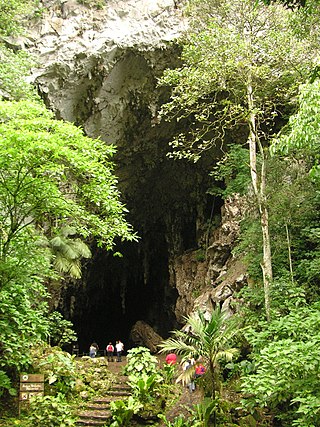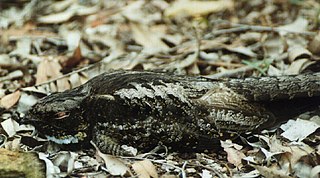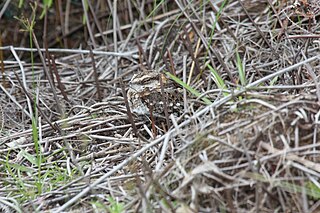
Nightjars are medium-sized nocturnal or crepuscular birds in the family Caprimulgidae and order Caprimulgiformes, characterised by long wings, short legs, and very short bills. They are sometimes called bugeaters, their primary source of food being insects. Some New World species are called nighthawks. The English word nightjar originally referred to the European nightjar.

Aerodramus is a genus of small, dark, cave-nesting birds in the Collocaliini tribe of the swift family. Its members are confined to tropical and subtropical regions in southern Asia, Oceania and northeastern Australia. Many of its members were formerly classified in Collocalia, but were first placed in a separate genus by American ornithologist Harry Church Oberholser in 1906.

The common potoo, or poor-me-ones, or urutau is one of seven species of birds within the genus Nyctibius. It is notable for its large, yellow eyes and a wide mouth. Potoos are nocturnal and are related to nightjars and frogmouths. They lack the characteristic bristles around the mouths of true nightjars.

Caripe is a town in Caripe Municipality in the mountainous north of the state of Monagas in eastern Venezuela. The official name of the town is Caripe del Guácharo 'Caripe of the Oilbird', referring to a colony of nocturnal birds which lives in a nearby cave, the Cueva del Guácharo. The species was unknown to science until 1799 when Alexander von Humboldt came to Caripe during his Latin American Expedition.

The Guácharo Cave National Park is located 12 km (7.5 mi) from the town of Caripe, Monagas, Venezuela. It has as its centerpiece a large limestone cave.

The Cueva de la Quebrada del Toro is a cave in the Sierra de Falcón in Falcón State, Venezuela. It is an active river cave, through which flows the largest known underground watercourse in Venezuela. It is protected as the Cueva de la Quebrada del Toro National Park.

The eared nightjars are a small group of nocturnal birds in the nightjar family, although the taxonomy is uncertain. There are seven species, mainly found in forest and scrub from China to Australia. Five species are placed in the genus Eurostopodus, the other two species in Lyncornis. They are long winged birds with plumage patterned with grey and brown to camouflage them when resting on the ground. They feed on insects caught in flight. A single white egg is laid directly on the ground and incubated by both adults. The chicks can walk soon after hatching.

Bates's nightjar or the forest nightjar, is a bird species of the family Caprimulgidae, found in the rainforests of western Sub-Saharan Africa.

The white-tailed nightjar is a species of nightjar in the family Caprimulgidae. It is found in the tropic regions of Central and South America.

The rufous nightjar is a species of nightjar in the family Caprimulgidae. It is found in Argentina, Bolivia, Brazil, Colombia, Costa Rica, Ecuador, Guyana, Panama, Paraguay, Peru, Saint Lucia, Suriname, Trinidad and Tobago, and Venezuela.

The sand-colored nighthawk is a species of nightjar in the family Caprimulgidae. It is found in Bolivia, Brazil, Colombia, Ecuador, Peru, and Venezuela.

The band-tailed nighthawk is a species of nightjar in the family Caprimulgidae. It is widely spread throughout northern and central South America. There are currently 5 subspecies. They are most vocal during the night time, indicating that they are nocturnal birds. They have an insectivorous diet, and feed on flying insects. Band-tailed nighthawks have an interesting reproductive strategy. Instead of building traditional nests, they lay their eggs directly on the ground, typically in concealed locations within their forested habitats. This adaptation may help reduce the chances of nest predation.
Aripo Cave is a cave in the Northern Range, in Trinidad and Tobago. This is the longest accessible cave in Trinidad and Tobago, with 862 m length and 160 m depth. It is one of several caves created by recrystallised limestone. The cave is a notable bat roost, and that bats contribute considerable amounts of guano, which in turn support vast numbers of cave-dwelling invertebrates.
Dunston Cave is an igneous cave on the Northern Range of Trinidad and Tobago. The cave is located on the grounds of the Asa Wright Nature Centre. Originally named Guacharo Cave, it was renamed Dunston Cave in 1972 in honour of engineer John Dunston. The caves are home to an Oilbird colony. These are the only nocturnal fruit eating birds in the world. They forage at night, navigating by echolocation in the same way as the bats.
Cumaca Cave is a large cave system located in northern Trinidad, in the southeastern area of the Northern Range. This cave is sometimes also called Oropouche. The caves are home to bats and Oilbirds. These are the only nocturnal fruit eating birds in the world. They forage at night, navigating by echolocation in the same way as bats, but with a high-pitched clicking sound audible to humans.
La Vache is a cave in located in the Northern Range, on the north coast of Trinidad. The Caves are home to the Oilbirds, These are the only nocturnal fruit eating birds in the world. They forage at night, navigating by echolocation in the same way as bats.
Lopinot Cave is a large cave in the Lopinot Valley in the Northern Range of Trinidad and Tobago. The Caves are home to the Oilbirds. These are the only nocturnal fruit eating birds in the world. They forage at night, navigating by echolocation in the same way as bats. It is a 1.5 hour drive from the capital

Paraprefica is an extinct genus of potoo from the middle Eocene. Its fossil remains have been found in the Messel pit at Messel, Germany.

Strisores, sometimes called nightbirds, is a clade of birds that includes the living families and orders Caprimulgidae, Nyctibiidae (potoos), Steatornithidae (oilbirds), Podargidae (frogmouths), Apodiformes, as well as the Aegotheliformes (owlet-nightjars) whose distinctness was only recently realized. The Apodiformes and the Aegotheliformes form the Daedalornithes.





















